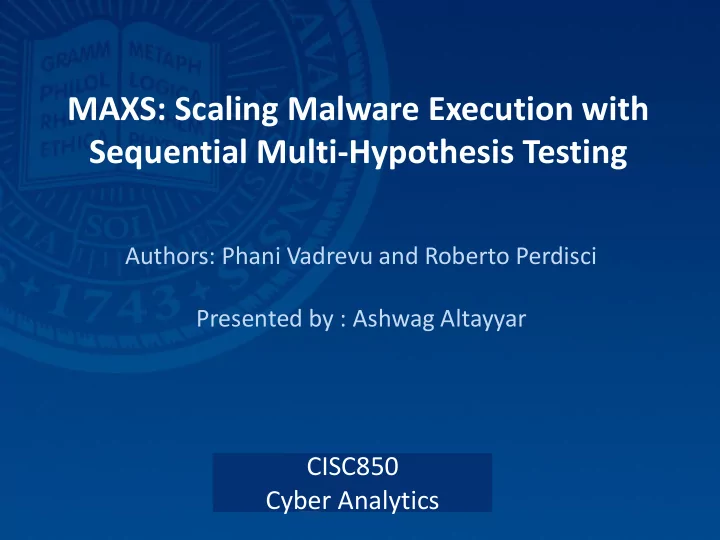

MAXS: Scaling Malware Execution with Sequential Multi-Hypothesis Testing Authors: Phani Vadrevu and Roberto Perdisci Presented by : Ashwag Altayyar CISC850 Cyber Analytics
Bare-metal Analysis Environments • Forcing the malware sample to run on a native system. • Incurring a high hardware costs. • Therefore, limiting the number of malware samples.
Problem statement • Malware analysis environments execute each sample blindly • Most new malware is repackaged previously analyzed malware.
Resource savings vs Information loss • Reducing the number • Increasing the number of malware samples of malware samples • Reducing execution • Increasing execution time time • Losing information • Saving information • Increasing the number of malware samples. • Reducing the amount of execution time. • Minimizing the risk of information loss.
MAXS(Malware Analysis eXecution Scaler ) A novel probabilistic multi-hypothesis testing framework for scaling execution in malware analysis environments, including bare-metal execution environments.
Goals and Benefits: • Increasing the capacity of malware analysis environments by reducing the execution time for each sample. • Minimizing the information loss.
• MAXS provides a new probabilistic decision framework . • Every time a new event is observed : 1- The probability that the sample belongs to a previously learned malware family. 2- The probability that the sample will generate previously unseen malware behaviors.
MAXS FRAMEWORK 1- A learning phase 2- An operational phase
Learning Phase • Measuring the similarity by computing the Jaccard index. • Using DBSCAN clustering algorithm (Density-based spatial clustering of applications with noise) .
Operational Phase main parameters to examine the Probabilities Threshold to examine the probability (Pf) Threshold to examine the probability (Pb)
EVALUATION Goal : • Decreasing the execution time while minimizing the information loss • Dataset: • Two large collections of malware execution traces obtained from two different production-level analysis environments (SA , SB) • 1,251,865 malware samples from SA, and 400,041 from SB
Experiments Setup • Appling to different types of events: – Domain name queries extracted via dynamic analysis – Malware information extracted via static analysis • Measuring time savings and information loss
Experiment 1: Malware Domain Intelligence • MAXS monitors the sequence of domain name queries • performed on both datasets MA and MB.
Parameter Selection B = 0.05 and Y = 0.1, time savings above 40% with less than 0.1% of sample with information loss
Longitudinal Train-Test Experiments Dataset MA: • Over three months (July, August, and December 2013) • Three contiguous days for training and building the family behavior profiles. • The next day for testing and measuring the time savings and information loss . Dataset MB: • Over six days (November 2014 ) • One day of malware samples for training and one day for testing.
Longitudinal Train-Test Experiments dataset median time median domain-based median samples responsible savings information loss for loss MA 42.2% 0.25% 0.07% MB 45.5% 0.08% 0.03%
Summary of Result for Longitudinal Experiments
Experiment 2: Leveraging Static Analysis Information • Clustering the malware samples based on static analysis features and building family behavior profiles. • Testing a new sample to decide whether it should be executed or not
The Result of Applying MAXS on Static Analysis Information
Combining Static and Dynamic Analysis • Appling MAXS on static analysis information • For every malware sample executed in the first step, t apply MAXS over the network events
Conclusion The experimental results show that: • Reduce malware execution time in average by up to 50%, with less than 0.3% information loss. • Lower the cost of bare-metal analysis environments.
Recommend
More recommend